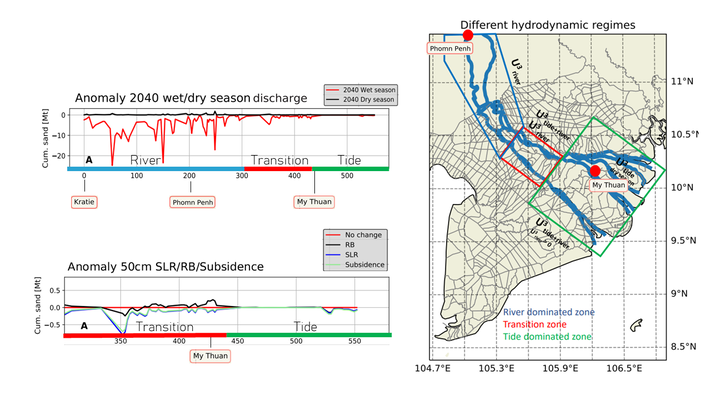A. Kwadijk1*, M. van der Vegt1 , M. van der Wegen2
1 Universiteit Utrecht, Netherlands; 2 Deltares, Netherlands
* Corresponding author: a.kwadijk@students.uu.nl
Introduction
As sand is a key building element of deltas, human interference with sand transport changes the delta. Local sand mining practises have already proven to be the main driver for morphological changes, including river bed lowering, resulting in accelerated loss of land and salinisation in the delta. Other morphological changes that contribute to these problems are delta-wide subsidence due to groundwater extraction and global sea level rise (SLR). Furthermore, upstream dam construction has resulted in a redistribution of discharge from the wet season to the dry season. How these anthropogenic perturbations in the deltas hydrodynamics and morphology alter the deltas internal sand dynamics remains a topic for ongoing debate.
Objective and Methods
This study aims to provide an overview on the projected changes on the deltas internal sand dynamics due to SLR, subsidence, river bed lowering and discharge alteration by dams. For this, a delta-wide DELFT3D-FM hydro- and morphological model is used. Simulations of one year were executed to test the systems response to SLR, subsidence, river bed lowering and an altered discharge separately. Furthermore, two scenarios for 2040 were investigated where projected changes for each perturbation were implemented collectively.
Results
Distinct responses for different hydrodynamic regimes were found:
- In the fluvial dominated regime seaward sand transport rates are highly variable along the river transect. Since dry season discharge is negligible compared to the wet season discharge, a reduction in the latter results in a reduced net import of sand annually. River bed lowering does not alter annual sand transport rates but increases the seasonality in sand transport.
- In the fluvial-tidal regime water depth increase as a result of river bed deepening causes an amplification of the tidal velocity amplitude. Consequently, seaward sand transport rates increase in this region and higher erosion rates can be expected.
- In the tide-dominated regime changes in discharge show little effect on sand transport rates. Due to the wide channels present in this region, an increase in water depth as a result of SLR, subsidence and river bed deepening results in a significant growth of the channels cross sectional area. This causes flow velocities and associated sand transport to decrease.
Since these regimes and anthropogenic perturbations are familiar for many other tidal deltas worldwide, the results of this study can act as an example on the expected morphological changes for other deltas worldwide.

Upper left graph: Annual cumulative sand transport anomaly for an altered discharge due to upstream dam construction. Red indicates the wet and black the dry season along the main branch of the Mekong River. Lower left graph: Indicates anomalies in sand transport in the fluvial-tidal and tidal zone as a response to subsidence, SLR and river bed lowering (RB). Right figure: Indicates the different hydrodynamic regimes identified in the study area.
References
Eslami, S., Hoekstra, P., Minderhoud, P. S., Trung, N. N., Hoch, J. M., Sutanudjaja, E. H., Dung, D. D., Tho, T. Q., Voepel, H. E., Woillez, M. N., & van der Vegt, M. (2021). Projections of salt intru sion in a mega-delta under climatic and anthropogenic stressors. Communications Earth & Environment 2021 2:1, 2(1), 1–11. https://doi.org/10.1038/s43247-021-00208-5
Hackney,C.R.,Darby,S.E.,Parsons,D.R.,Leyland,J.,Best,J.L.,Aalto,R.,Nicholas,A.P.,&Houseago, R. C. (2020). River bank instability from unsustainable sand mining in the lower Mekong River. Nature Sustainability 2020 3:3, 3(3), 217–225. https://doi.org/10.1038/s41893-019 0455-3










